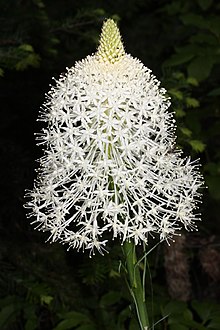Bear grass
| Bear grass | ||||||||||||
|---|---|---|---|---|---|---|---|---|---|---|---|---|

Beargrass ( Xerophyllum tenax ) in Glacier National Park in Montana, USA |
||||||||||||
| Systematics | ||||||||||||
|
||||||||||||
| Scientific name | ||||||||||||
| Xerophyllum tenax | ||||||||||||
| ( Pursh ) Nutt. |
The bear grass ( Xerophyllum tenax ) is one of two plant species of the genus Xerophyllum . In the botanical sense it is not a grass , but belongs to the Germer family (Melanthiaceae).
description
Beargrass is a perennial herbaceous plant that reaches heights of between 1.2 and 1.8 m. The roots are thick. It forms woody rhizomes that end in tubers (with “tunic”). Upright and unbranched shoots sprout from this , bloom only after a few years and die off after seed formation. The foliage leaves, which are largely arranged in a spiral at the base, but also around the stem , are thin-linear, keeled, between 10 and 80 cm long and 2 to 4 mm wide. The leaf margin is sawn.
In spring or early summer, a 50 to 70 cm high, terminal racemose inflorescence is formed with closely spaced flowers and bracts. The small, fragrant flowers are hermaphroditic and threefold. The six more or less identical, cream-white bracts (tepals) are 6 to 9 mm long and 2 to 3 mm wide. There are two circles with three stamens each; they are 3 to 4 mm long. Three carpels have grown together to form an upper ovary. The three free styluses are 4 mm long.
There are 5 to 7 mm long, spherical to egg-shaped, loculicidal capsule fruits formed, each containing four seeds per fruit compartment. The greenish-brown seeds are triangular, 3 to 4 mm in size and wingless.
The number of chromosomes is 2n = 30.
ecology
Beargrass is perfectly adapted to the forest fires that are common in its area of distribution . After that, it is often the first plant species to grow again, as the rhizomes survive underground.
distribution
Bear grass inhabits open coniferous forests , dry slopes, scree soils and clearings and altitudes up to 2,300 m. It is found mainly in western North America , from Canadian British Columbia in the north to southern California and in the east to Wyoming . It is common in the coastal chain , on the Olympic Peninsula , in the Cascade Range , the northern Sierra Nevada and the Rocky Mountains .
Cultural meaning
The fibers of the leaves of the bear grass were woven into clothing and decorative waterproof baskets by the indigenous peoples . The fleshy rhizomes were roasted for several days and then eaten.
Today the leaves are often used as binding green in floristry .
Systematics
The German-Canadian botanist Frederick Traugott Pursh described this species in 1813/14 under the name Helonias tenax in Fl. Amer. sept. 1: 243, t. 9, 1813-1814. The name valid today was published in 1818 by the English botanist Thomas Nuttall in Gen. N. Amer. pl., 1818, 1: 235.
Individual evidence
- ^ Xerophyllum tenax at Tropicos.org. In: IPCN Chromosome Reports . Missouri Botanical Garden, St. Louis
- ↑ Xerophyllum. In: GRIN. Taxonomy for Plants.
literature
- Frederick H. Utech: Xerophyllum. In: Flora of North America. Vol. 26. Oxford University Press, New York NY 2002, p. 72. ISBN 0-19-515208-5 (English)
- SM Maule: Xerophyllum tenax, squawgrass, its geographic distribution and its behavior on Mount Rainier, Washington. In: Madroño. San Francisco 15.1959, pp. 39-48.
Web links
- Xerophyllum. In: Jepson Flora Project. (English)

